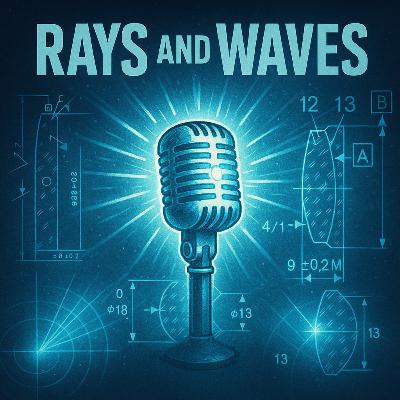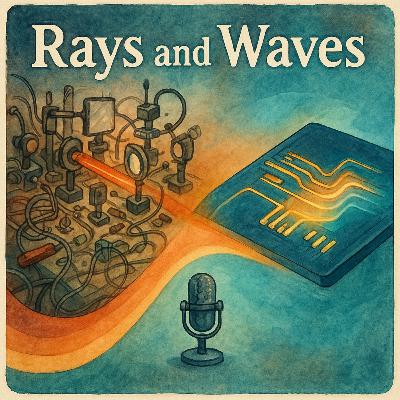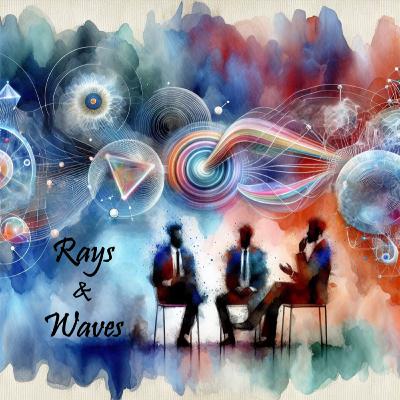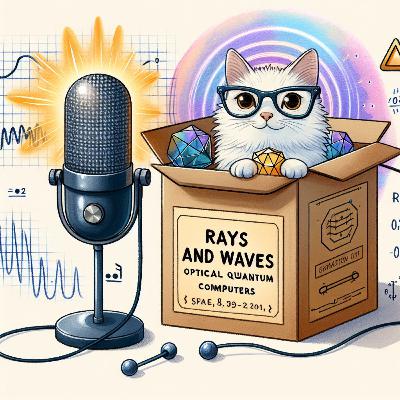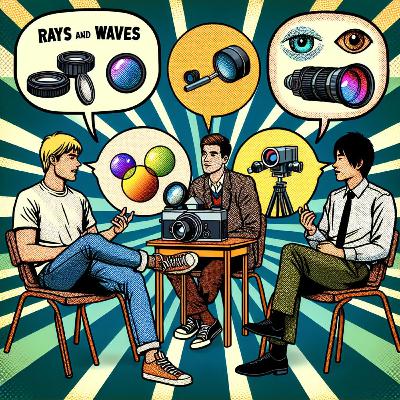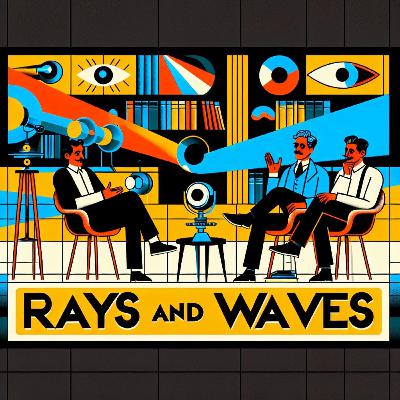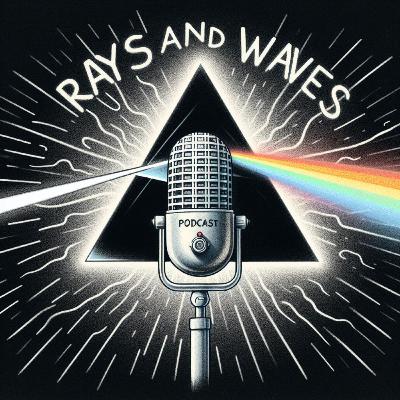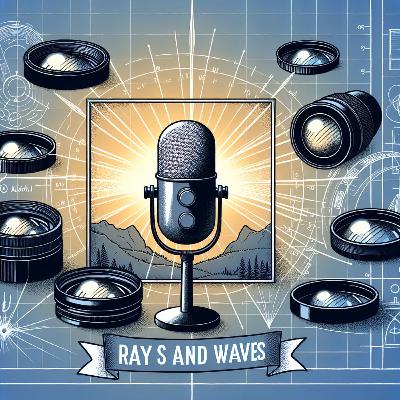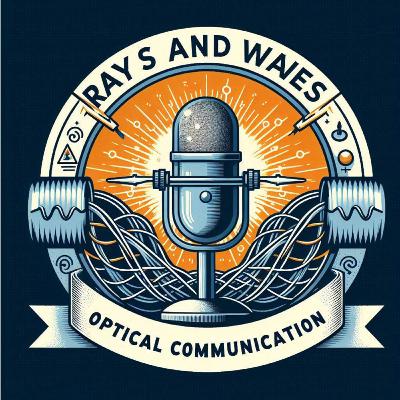Discover Rays and Waves
Rays and Waves

Rays and Waves
Author: Rays and Waves
Subscribed: 3Played: 21Subscribe
Share
© Rays and Waves
Description
Rays and Waves, a passion project of two optical engineers, Daniel and Steve, who moonlight as podcast hosts. Join them as they explore the beautiful world of optics and photonics. The topics will span across the whole optical universe, demonstrating the versatile applications of optical engineering and sometime feature prominent characters from the community. Ready to dive into the captivating world of photonics?
10 Episodes
Reverse
Standards may not grab headlines, but they quietly shape the world. In this episode of Rays and Waves, we shine a light on the unsung hero of modern optical engineering: optical standards.From the fiber optics enabling global connectivity, via laser grocery scanners, to the precision lenses the James Webb telescope, none of it works without agreed-upon rules and measurements. These standards ensure interoperability, safety, and reliability across millions of devices.Joining Daniel and Steve is Eric Herman, a dedicated volunteer helping to develop and maintain these critical frameworks. Together, we’ll explore how standards are created, the challenges of keeping pace with cutting-edge technology, and why this work matters more than ever.If you enjoy the show, share it with your colleagues, subscribe, and leave us a review! Got thoughts or questions? Reach out at rays.and.waves.podcast@gmail.comIntro music is Good Vibe by Twisterium. Thanks for the great tunes!
In this episode, we sit down with Erwin De Baetselier, the CEO of Luceda, a company at the forefront of software innovation for Photonic Integrated Circuits (PICs). As PICs continue to reshape the landscape of optical systems—from data centers to quantum labs—the tools used to design and simulate them are becoming just as critical as the hardware itself.Luceda’s software empowers engineers and researchers to model, optimize, and scale photonic designs with precision and speed. We dive into how their platform bridges the gap between photonic theory and manufacturable reality, and why design automation is key to unlocking the full potential of integrated photonics.Whether you're deep in the weeds of waveguide layouts or just curious about the future of chip-scale optics, this conversation offers a behind-the-scenes look at the software driving the PIC revolution. Join Steven and Daniel as they explore the intersection of photonics and design automation with Luceda’s visionary leader.If you enjoy the show, share it with your colleagues, subscribe, and leave us a review! Got thoughts or questions? Reach out at rays.and.waves.podcast@gmail.comIntro music is Good Vibe by Twisterium. Thanks for the great tunes!
In this episode, we explore the rise of Photonic Integrated Circuits (PICs), which aim to compress the sprawling optical setups found on lab benches into compact, chip-scale systems. These integrated platforms are becoming foundational for technologies like high-speed data communication, LIDAR, optical quantum computing, AR/VR, and biotech diagnostics—where size, modularity, and manufacturability are critical.We take a closer look at how PICs are built, what makes them so transformative, and why the market is growing at a rapid pace. Whether you're an engineer, researcher, or just fascinated by the future of photonics, this episode offers a view into the architecture driving next-gen optical systems. Join Steven and Daniel as they explore PICs!If you like the show, tell your friends and colleagues about it! And like, subscribe, and all that! If you want to get in touch, shoot us an email on rays.and.waves.podcast@gmail.comIntro music is Good Vibe by Twisterium. Thanks for making sweet music!
In the last episode of Rays and Waves about linear optical quantum computers we discussed how using photons as qubits is good in many ways. However, the biggest hurdle is that photons don’t like interacting with each other, which makes the critical two-qubit gates difficult to create. But a 2001 discovery showed it was in fact possible to effectively make two-qubit interactions and therefore a full quantum computer solely with linear optical elements, single photon sources and detectors. This discovery catalysed a wealth of research into optical quantum computers which in aggregate has today made it a viable contender to a path to scalable fault tolerant quantum computers.The scheme that opened the floodgates for optical quantum computers is referred to as the KLM protocol after its originators Knill, Laflamme, and Milburn.For this episode we have the honour of talking to said Milburn on the Rays and Waves podcast!If you like the show, tell your friends and colleagues about it! And like, subscribe, and all that! If you want to get in touch, shoot us an email on rays.and.waves.podcast@gmail.comStuff mentioned in the episode:- Looking Glass Universe video about Quantum Eraser: https://www.youtube.com/watch?v=sAm7iVdAvTA&t=1154s- Ezra Klein interview about AGI: https://youtu.be/Btos-LEYQ30?feature=sharedIntro music is Good Vibe by Twisterium. Thanks for making sweet music!Outro music is Slowly Comes The Angels by fermionik
In this episode of Rays and Waves we speak about Linear Optical Quantum Computers. There has been lots of talk about quantum computers in the science media lately. Both companies and academic labs are hard at work to build the sought-after fault-tolerant quantum computer.As it turns out, one approach to building quantum computers is with optics. Join us as we explore the pros and cons with this light-based approach to quantum computers.If you like the show, tell your friends and colleagues about it! And like, subscribe, and all that! If you want to get in touch, shoot us an email on rays.and.waves.podcast@gmail.comGood resources to learn more:- Original KLM paper: Knill, Emanuel, Raymond Laflamme, and Gerald J. Milburn. "A scheme for efficient quantum computation with linear optics." nature 409.6816 (2001): 46-52.- Good review: Slussarenko, Sergei, and Geoff J. Pryde. "Photonic quantum information processing: A concise review." Applied physics reviews 6.4 (2019).- Lecture notes: Myers, C. R., and R. Laflamme. "Linear optics quantum computation: an overview." Quantum Computers, Algorithms and Chaos (2006): 45-93.Game: Quantum Odyssey (https://store.steampowered.com/app/2802710/Quantum_Odyssey/)Intro music is Good Vibe by Twisterium. Thanks for making sweet music!
In this episode of Rays and Waves we speak to Katsumoto Ikeda. Kats runs a brilliant webpage about optical design called “A Pencil of Rays” (https://www.pencilofrays.com/). He has worked as an optical designer for well over a decade. and is now the Application Engineer Manager at Ansys in Japan. Join Daniel, Steven, and Kats in a riveting conversation about optical design.If you like the show, tell your friends about it! And like, subscribe, and all that! If you want to get in touch, shoot us an email on rays.and.waves.podcast@gmail.comIntro music is Good Vibe by Twisterium. Thanks for making sweet music!
In this episode of Rays and Waves we speak to Mark Nicholson. Few people have made a bigger impact on how modern optics is designed and analysed. Mark was for 30 years involved with Zemax, one of the optical design software giants on the market. Nowadays Mark is retired, but continues to heavily impact the optics industry by running a YouTube channel called Design Optics Fast which teaches a modern approach to optical design. Join Daniel and Steve as they quiz Mark on his career and best advice to coming optics generation.If you like the show, tell your friends about it! And like, subscribe, and all that! We'd love to hear from you, so feel free to reach out via email at rays.and.waves.podcast@gmail.comIntro music is Good Vibe by Twisterium. Thanks for making sweet music!
In this episode of Rays and Waves we get to know the podcast purpose and the hosts a bit. Join Daniel and Steve in the episodes to come as they explore the vast world of optics.
If you like the show, tell your friends about it! And like, subscribe, and all that! If you want to get in touch, shoot us an email on rays.and.waves.podcast@gmail.com
Intro music is Good Vibe by Twisterium. Thanks for making sweet music!
In this episode of Rays and Waves we speak about Optical Design. Optical products are all around us, ranging from phones, cameras, cars, communication, grocery shopping, medical devices, and almost everything in between. How to design them? Join Daniel and Steve as they explore optical design from fundamentals of the thin lens equation learned in high school physics to how high-level optical systems are designed today.
If you like the show, tell your friends about it! And like, subscribe, and all that! If you want to get in touch, shoot us an email on rays.and.waves.podcast@gmail.com
Intro music is Good Vibe by Twisterium. Thanks for making sweet music!
In this episode of Rays and Waves we speak about Optical Communication. Join Daniel and Steve as they explore how information transfer through hair-thin glass fibres are changing the world. While data rates have grown by over 10 billion times since the first commercial systems we are still signalling the fall of Troy with fire beacons by blinking lights on and off, only mind-numbingly fast!
If you like the show, tell your friends about it! And like, subscribe, and all that! If you want to get in touch, shoot us an email on rays.and.waves.podcast@gmail.com
Intro music is Good Vibe by Twisterium. Thanks for making sweet music!


